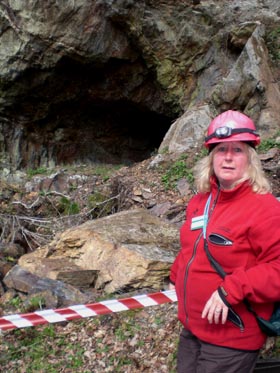
| 
|

 Dolaucothi Gold Mines - Malvern's Rival
Dolaucothi Gold Mines - Malvern's RivalPumsaint
Carmarthenshire
United Kingdom
SA19 8US
Telephone: 01558 650 177
There are a number of similarities between the history of the Malvern Hills Goldmine and those at Dolaucothi, also known as the Ogofau Gold Mine in Carmarthenshire. Whilst the Malvern mine never went on to enjoy the acclaim of the Welsh mine, common aspects of the history of both make Dolaucothi worth noting. Today the Welsh site is operated by the National Trust as a visitor centre.
The Welsh mine lies about 90 miles west of Malvern and both locations are situated on the ancient geological collision belt that runs NE/SW across
As the Roman exploitation drew to a close the locality appears to have had little activity for 1200 years until in 1695 it is referred to in a reference work. This date coincides with the discovery of gold in
During the mid 18th century there were efforts to locate workable deposits and trail shafts were dug. It was not until the mid 19th century that the South Wales Gold Mining Company pursued extensive exploration. Little gold was found and the company closed in 1897.
The early 20th century saw James Mitchell reopen the mine. Gold was found but it was not commercially workable. The operation closed in 1912.
The 1930s saw new developments in the technology of mining that enabled gold to be commercially mined at Dolaucothi. At one time the workforce numbered about 200 and the ore was shipped abroad for separation. The mine closed for the last time in 1938.
Water for the workings throughout the mine history came from the Cothi river which was transferred to the site via aqueducts etc.
Email: dolaucothi@nationaltrust.org.uk (click here to send an email)
Website: Click Here
SUPPLEMENTARY INFORMATION
There are a number of similarities between the history of the Malvern Hills Goldmine and those at Dolaucothi, also known as the Ogofau Gold Mine in Carmarthenshire. Whilst the Malvern mine never went on to enjoy the acclaim of the Welsh mine, common aspects of the history of both make Dolaucothi worth noting. Today the Welsh site is operated by the National Trust as a visitor centre.
To explore Malvern's gold mining click this text
Map: (Click to View in New Window)
1) TOPOGRAPHICAL LOCATION:
Wales
2) LANDSCAPE:
Mountains3) INFORMATION CATEGORY:
Retail Gift or Souvenir ShopGeology & Landscape
History & Heritage
Tourism Information Point
5) GENERAL VISITOR INFORMATION:
Access By RoadAccess On Foot
Free Parking Nearby
Disabled access
Toilets


